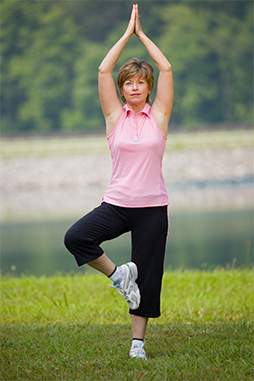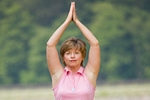
Every year, more than 2 million Americans are treated in the emergency room for injuries related to falls. The consequences of falling at an old age can be quite severe given the lowered bone density, weakened muscles, and decreased capacity of the body the heal itself as you grow older. In fact, falls are the leading cause of accidental deaths in the people above the age of 65.
The good news is falls do not necessarily have to be a part of growing old. Balance training at any age can go a long way in helping prevent falls and avoiding disability. Let’s look at some exercises you can do to improve your balance.
- Stand on one foot: A simple, but effective exercise to develop your stabilizing muscles. If you are unsure of performing the exercise, hold on to a sturdy chair for support. Lift one foot off the ground and balance on the other for 10 seconds. Then do the same thing with the other foot. As your balance improves, you should be able to do the exercise without any support.
- Eye tracking: While standing upright, hold your thumb out in front of you with your arm bent. Move your thumb to the right, left, up, and down while tracking your thumb with your eyes. Next straighten your arm out and perform the same exercise, but this time move your whole head to track the movement of your thumb. Stop the exercise if you feel slightly dizzy at any time.
- Staggered stance: From a standing position, take one step forward and hold the stance for 10 seconds. Then bring the foot back and repeat with the other foot. To take it up a notch, try doing the exercise with your eyes closed.
- Body circles: Stand with your feet shoulder width apart. Keeping your body straight, slowly sway in a circle for about 1 minute. The exercise gets more challenging when you bring your feet close together.
- Heel-to-toe walk: Simply place the heel of one foot in front of the toe of the other foot and move forward with slow, deliberate movements. You can support yourself by holding on to a counter or a wall initially until your balance improves.
Remember to practice these exercises every day and you will be doing your part to minimize your risk of falls and their more serious consequences. As a precaution, you may want to check with your doctor or an orthopedic physician regarding the condition of your bone and joint health prior to starting a new exercise routine.
Dr. Domb is a nationally recognized orthopaedic surgeon specializing in sports medicine and arthroscopic surgery of the hip, shoulder and knee. A noted pioneer in advanced new techniques in hip arthroscopy, he delivers innovative treatments for patients with hip injuries such as impingement and labral tears. Dr. Domb is also an expert in arthroscopic surgery of the shoulder and knee, adept in specialized techniques including arthroscopic rotator cuff repair and all-inside ACL reconstruction.

